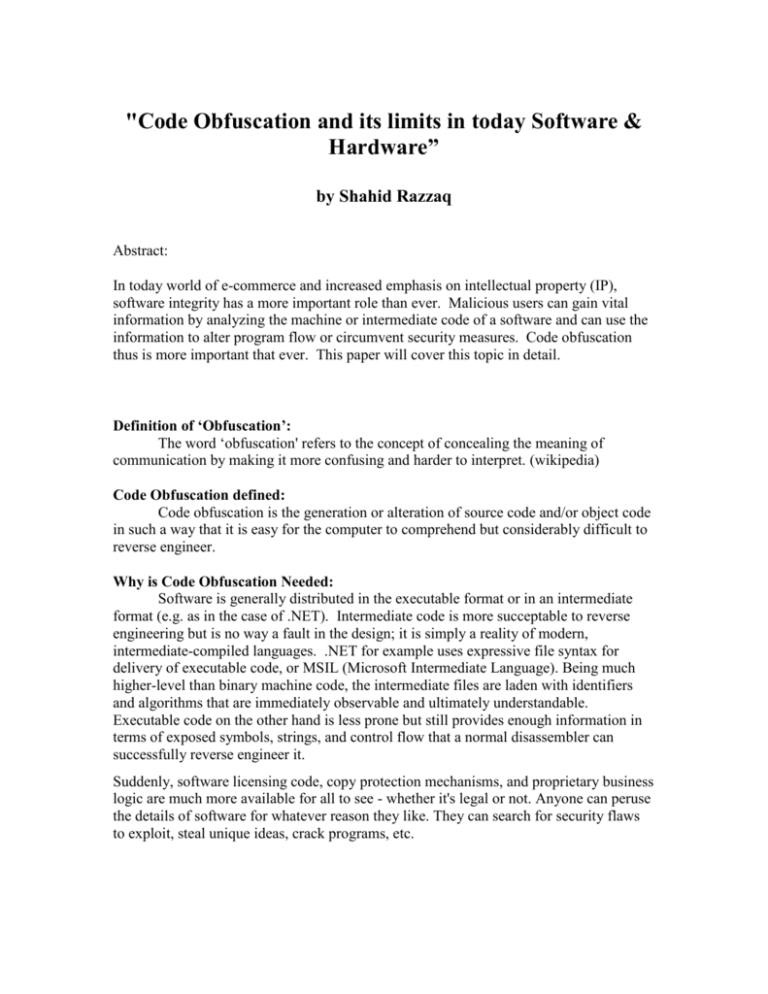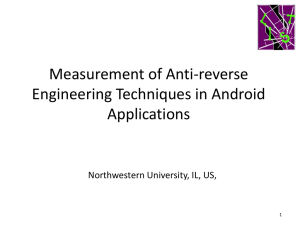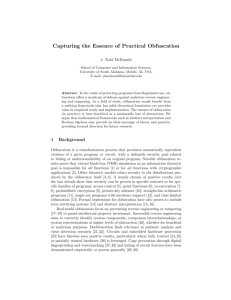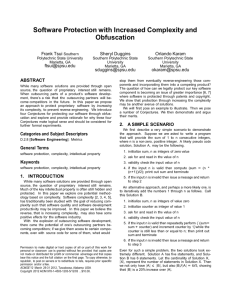paper
advertisement

"Code Obfuscation and its limits in today Software &
Hardware”
by Shahid Razzaq
Abstract:
In today world of e-commerce and increased emphasis on intellectual property (IP),
software integrity has a more important role than ever. Malicious users can gain vital
information by analyzing the machine or intermediate code of a software and can use the
information to alter program flow or circumvent security measures. Code obfuscation
thus is more important that ever. This paper will cover this topic in detail.
Definition of ‘Obfuscation’:
The word ‘obfuscation' refers to the concept of concealing the meaning of
communication by making it more confusing and harder to interpret. (wikipedia)
Code Obfuscation defined:
Code obfuscation is the generation or alteration of source code and/or object code
in such a way that it is easy for the computer to comprehend but considerably difficult to
reverse engineer.
Why is Code Obfuscation Needed:
Software is generally distributed in the executable format or in an intermediate
format (e.g. as in the case of .NET). Intermediate code is more succeptable to reverse
engineering but is no way a fault in the design; it is simply a reality of modern,
intermediate-compiled languages. .NET for example uses expressive file syntax for
delivery of executable code, or MSIL (Microsoft Intermediate Language). Being much
higher-level than binary machine code, the intermediate files are laden with identifiers
and algorithms that are immediately observable and ultimately understandable.
Executable code on the other hand is less prone but still provides enough information in
terms of exposed symbols, strings, and control flow that a normal disassembler can
successfully reverse engineer it.
Suddenly, software licensing code, copy protection mechanisms, and proprietary business
logic are much more available for all to see - whether it's legal or not. Anyone can peruse
the details of software for whatever reason they like. They can search for security flaws
to exploit, steal unique ideas, crack programs, etc.
The process of reverse engineering an executable program typically begins with
disassembly, which translates machine code to assembly code. This is then followed by
various decompilation steps that aim to recover higher-level abstractions from the
assembly code. When it is properly applied, obfuscation can increase the protection
against decompilation by many orders of magnitude, while leaving the application intact.
It can be stated that the “goal of code obfuscation is to make reverse engineering of
programs ‘infeasable’, while maintaining the logic on the program with nominal effects
on performance”.
(Obfuscation generally has the effect of decreasing the memory footprint of a program
while increasing the time taken to execute tasks)
Alternatives:
Obfuscation is the technology of shrouding the facts. Although encryption can make your
assembly completely unreadable, this methodology suffered from a classic encryption
flaw, it needed to keep the decryption-key with the encrypted data. So, an automated
utility could be created to decrypt the code and put it out to disk. Once that happens the
fully unencrypted, unobfuscated code is in plain view. Hence encryption of code and
data by itself cannot solve the problem of reverse engineering.
More definitions:
Obfuscator: These are tools perform code obfuscation, i.e they are used to convert a
straight-forward program into one that works the same way but is much harder to
understand and reverse engineer. They perform obfuscation on source code, object code,
or both
De-obfuscator: As the name implies, these are tools that reverse engineer obfuscated
code.
Indepth look at Code Obfuscation:
There are multiple ways in which code can be obfuscated, each hiding certain aspects of
the program:
1. Code Structure Obfuscation:
This is preventing users from gaining knowledge about the structure of code in
memory. By default, compiled byte-code contains a lot of debugging information: source
file names, line numbers, field names, method names, argument names, variable names,
etc. This information makes it straightforward to decompile the byte-code and reverseengineer entire programs. The goal behind code obfuscation is to remove the debugging
information and replace all names by meaningless character sequences, making it much
harder to reverse-engineer the code. This further compacts the code, decreasing the final
footprint. The program remains functionally equivalent, except for the class names,
method names, and line numbers. Renaming to unprintable characters or confusing
sequences is also used to foil decompiled output.
2. Data Obfuscation:
As the name implies, this includes hiding the data like strings or any data type.
Strings are encrypted to hide their contents and pages containg the encrypted data is only
decrypted upon usage of the strings. Crackers will frequently search for specific strings
in an application to locate strategic logic. For example, someone looking to bypass a
registration and verification process can search for the string displayed when the program
asks the user for a serial number. When the attacker finds the string, he can look for
instructions near it and alter the logic. String Encryption makes this much more difficult
to do, because the attacker's search will come up empty.
3. Control Obfuscation:
Hides the flow of control in the execution of code to confuse the user but still
maintains the overall logic of code. This process synthesizes branching, conditional, and
iterative constructs that produce valid forward (executable) logic, but yield nondeterministic semantic results when decompilation is attempted. Control Flow
obfuscation produces spaghetti logic that can be very difficult for a cracker to analyze.
This is important as many smart disassemblers create control flow graphs to ease in
reverse engineering. (Dotfuscator)
4. Preventive Obfuscation:
Done to prevent reverse engineering of code. Added bogus data prevents deobfuscator from automatic analysis Reverse engineering is usually accomplished by
smart programs like IDA Pro (http://www.datarescue.com/idabase/) which creates call
graphs and tracks variables to help reverse engineer code. Preventive obfuscation is for
hampering such techniques.
Debugging Obfuscated Code:
One major drawback of obfuscation is that the task of maintaining and
troubleshooting an obfuscated application becomes more difficult. In a well obfuscated
application, the names of all types, methods, and fields are changed from their carefully
thought out, informative names into meaningless, semi-random names. This impacts the
usefulness of bug reports sent in from the field in the form of stack traces. A stack trace is
essentially a listing of where in the program a problem occurred. The list includes the
names embedded in the program (e.g. method and type names). A stack trace from an
obfuscated program will contain the obfuscated names, and will thus be very difficult to
read by support personnel and developers. Some obfuscator remedy this by providing a
way of automatically decodeing obfuscated stack traces using the renaming map file.
Given an obfuscated stack trace, the tool replaces the obfuscated names with the original
names and displays the results.
Renaming metadata to gibberish or less obvious identifiers is one of several defense
mechanisms. It's obvious that a function definition called InsterestRatesCalcuator () will
give any cracker a leading edge over various functions called x(). As you'll see in the
example below and as they stated, "Typically, an overload-induced project will have up
to 35 percent of the methods renamed to 'a'", it's an effective obfuscation strategy.
Similarly, some of the obfuscation techniques include removing nonessential metadata,
control flow obfuscation, string encryption, incremental obfuscation, and size reduction -all different ways to make decompilation and disassembling produce incomprehensible
output. Some generic techniques used by other obfuscation utilities include reordering the
instantiation and methods, manipulating inheritance relationships, variable scope
modification, mapping unboxed scalars (int, byte, etc) to corresponding object types, etc.
However, its very important to keep into consideration that obfuscation shouldn't end up
changing a program's logic or flow, as its purpose is to protect and not deform.
Why isn’t Obfuscation Prevalent:
There are reasons why Obfuscation isn’t as prevalent, despite the obvious benefits. Some
of the most viable reasons are:
1. Cost of obfuscation
2. Execution time
3. High program complexity
4. Effort
5. Higher cost of development
6. Ignorance about Obfuscation
Popular Obfuscation Tools:
Most of the obfuscation tools in the market are directed towards obfuscating .NET and
Jave applications. Amongst the more notable ones are:
Microsofts .NET Obfuscator – Dotfuscator
{smartassembly} 1.0
Goliath.NET Obfuscato
SecureLM - Code Protector
Spices.Net
Aspose.Obfuscator
Limits of Obfuscation:
Obfuscation tools mangle symbols and rearrange code blocks to foil decompiling. They
also may encrypt strings containing sensitive data. It's important to understand that
obfuscators (as they exist today) can't completely protect your intellectual property.
Because the code is on the client machine, a really determined hacker with lots of time
can study the code and data structures enough to understand what's going on. Obfuscators
do provide value in raising the bar, however, defeating most decompiler tools and
preventing the casual hacker from stealing your intellectual property. They can make
your code as difficult to reverse engineer as optimize native code.
Without argument, obfuscation (or even encryption) is not 100 percent protection. Even
compiled C++ is disassembleable. If a hacker is perseverant enough, they can find the
meaning of your code. The goal of obfuscation is to make the reverse engineering process
extremely time consuming and painful so that it not worth the effort. The goal is to stop
all casual hackers and as many serious hackers as possible.
Use of Hardware:
Encryption of code is another possibility. However, unless the entire
encryption/decryption process takes place in hardware, it is possible for the user to
intercept and decrypt the code. Unfortunately, specialised hardware tends to limit the
portability of programs.
Obfuscation in Code itself (i.e Pre-preprocessor, pre-compile time):
The following is a valid C code that spits out ’12 Days of Christmas’
lyrics when run. This is an example of how code is written in an
obfuscated way. This is fortunately limited to the interest of
hobbyinsts and has not found widespread usage in the Software industry.
(source code from wikipedia)
#include <stdio.h>
main(t,_,a)char *a;{return!0<t?t<3?main(-79,-13,a+main(-87,1-_,
main(-86,0,a+1)+a)):1,t<_?main(t+1,_,a):3,main(-94,-27+t,a)&&t==2?_<13?
main(2,_+1,"%s %d %d\n"):9:16:t<0?t<-72?main(_,t,
"@n'+,#'/*{}w+/w#cdnr/+,{}r/*de}+,/*{*+,/w{%+,/w#q#n+,/#{l,+,/n{n+,/+#n
+,/#\
;#q#n+,/+k#;*+,/'r :'d*'3,}{w+K w'K:'+}e#';dq#'l \
q#'+d'K#!/+k#;q#'r}eKK#}w'r}eKK{nl]'/#;#q#n'){)#}w'){){nl]'/+#n';d}rw'
i;# \
){nl]!/n{n#'; r{#w'r nc{nl]'/#{l,+'K {rw' iK{;[{nl]'/w#q#n'wk nw' \
iwk{KK{nl]!/w{%'l##w#' i; :{nl]'/*{q#'ld;r'}{nlwb!/*de}'c \
;;{nl'-{}rw]'/+,}##'*}#nc,',#nw]'/+kd'+e}+;#'rdq#w! nr'/ ') }+}{rl#'{n'
')# \
}'+}##(!!/")
:t<-50?_==*a?putchar(31[a]):main(-65,_,a+1):main((*a=='/')+t,_,a+1)
:0<t?main(2,2,"%s"):*a=='/'||main(0,main(-61,*a,
"!ek;dc i@bK'(q)-[w]*%n+r3#l,{}:\nuwloca-O;m
.vpbks,fxntdCeghiry"),a+1);}
Conclusion:
Obfuscation has some very obivous benefits of protecting intellectual property and
secrets and making reverse engineering of code difficult. It has found wide spread use in
digital rights management technologies where usage rights and content decryption keys
are protected.
References











